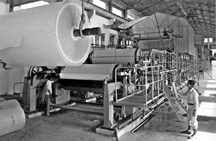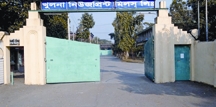Paper
Paper The name comes from papyrus, a form of writing material made from water reed, used in ancient Egypt. bamboo and mulberry tree were also used as major raw materials in preparing paper in indigenous cottage industry units of Bangladesh. People in different parts of Bengal, especially in murshidabad, rajshahi, rangpur, dinajpur and tangail used to make paper from mesta (hibiscus conabinus) and jute by using indigenous skills.

Varieties of papers were made and used in this country. Most important among them were afsani and tulot. The word tulot may have come from tula or cotton as at one time, paste was made from cotton and it was possibly used to make the pulp for the paper.
Afsani or jar afsan paper had a mixture of gold or silver powder for the consumption of the royalty. At one time Patna was famous for papermaking. Its paper was known as Patnai. When william carey first set up a printing press at his mission in serampore, he first used Patnai paper. Later, a paper making plant was established at Serampore. All books printed at the Serampore Press used its own paper for printing books. In those days rice starch was used to make paper hard but this attracted insects. Carey used some other technique to make paper hard. In 1820, the first steam engine in India was installed at the Serampore paper factory. Quite a few paper mills were established in British India. The paper mill at Titagarh was the most famous.
After 1947, the karnafuli paper mills was set up in chittagong, a newsprint mill in khulna and the North Bengal Paper Mill at pabna, all at government initiative. The Karnafuli Mill uses bamboo as raw material for making the pulp, the Khulna Newsaprint Mills uses gewa wood from the sundarbans and the North Bengal Mill uses bagasse. A pulp mill was set up at sylhet. It uses reed as raw material. But because of conversion of grassland to agricultural land, the mill now uses bamboo and hardwood. Attempts were made to use jute fibre for making pulp in the mill, but they failed due to process difficulties. The mill uses soda process, for which the pulp yield is low and the quality of pulp is also relatively poor.

Quite a number of new paper mills have been set up after the emergence of Bangladesh in the private sector. Some of them are Sonali Paper Mill, Hashem Paper and Pulp Mill, Hossein Paper Mill, Sadek Paper Mill, Magura Paper Mill, Bengal Paper Mill, Hakkani Paper Mill and Tongi Board Mill. These modern mills produce high quality paper using imported pulp. Used paper is recycled in some mills. Jute cutting and straw are also being used for making pulp. All these mills produce about 100,000 metric tons of paper a year.
Paper has innumerable varieties and qualities but usually paper can be divided into newsprint, white print, ledger paper, cover paper and board. Newsprint is made of wood pulp from such trees as pine, hemlock, fir and, in Bangladesh, gewa. Bangladesh Bureau of Statistics (BBS) classifies paper into four broad types: writing paper, printing paper, newsprint and packaging and other papers. According to BBS sources, the shares of these four types in the total volume of paper production in the country are approximately 15%, 35%, 40%, and 10%. The production of pulp, paper and paper products in the country falls much short of the local demand for them. At present, the value of annual imports of pulp, waste paper, paper, paperboard and articles thereof in Bangladesh is about Tk 4 billion.
Newsprint is the cheapest and has the least strength. Nothing meant for long preservation is printed on this paper as after sometime, it turns reddish and becomes brittle because higher quantity of resin used in making wood pulp starts oxidising in contact with light and air. The paper meant for printing books is of a wide variety. These are generally known as machine finish or MF, super calendar, antique finish and coated and art paper. MF is the common paper for printing. It is white, not stiff and medium bright. It is good for printing from all kinds of types including halftone screen. Super calendar is made by making MF paper stronger and smoother. This paper is very suitable for old style printing from types. Antique paper is usually made from pulp of old cloth giving it long life with its whiteness intact. It is not suitable for halftone but prints very well from line engraving and types.
Paper with higher degree of opaqueness is better for printing. To reduce transparency the paper's thickness is increased or some crushed China powder is mixed with the pulp. This process is known as loading. When this paper is smoothened or calendered well it is known as art or coated paper. Such paper is essential for printing fine screen halftone or very small types or delicate lines.
According to the English standard, paper is measured on the basis of the weight of a ream of 500 sheets. For instance, a ream of 500 sheets of 23' 36 size paper of standard thickness is 36 pounds. A thicker paper of the same size will weigh more. On this basis, however, it is not clear whether the paper of different sizes like double demy and double crown will be of the same quality. A measurement called GSM or gram per square metre has been introduced to rectify this confusion. A paper of 70 or 80 gsm means that a square metre of that paper weighs 70 or 80 grams. DIN, a new measurement introduced in Germany stands for Deutsche Industrie Normen and it classifies paper on the basis of the proportion of length and breadth of paper in folded form. [Fazle Rabbi]
